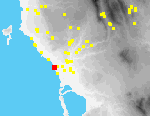 I18 Romanou Rikia
I18 Romanou Rikia
Site I18 is located ca. 3 km. SE of Vromoneri and ca. 1.5 km. NE of Romanou. Near the shore are fossilized calcarenite dunes, composed of a Pleistocene soil that is largely of Aeolian origin but contains some small cobbles and gravel that appear stream-borne. The crests of the dunes are for the most part covered with maquis, and their line marks the western edge of cultivated fields belonging to the former Kokkevis estate[091.05]; to the west of the dunes, the ground drops steeply to a maquis-covered beach terrace, and from there to the shoreline, ca. 90 m. away.[091.06]
Lithic artifacts were discovered in the eroding western scarp of one dune, and on the slope W of it, spread in a narrow band ca. 50 m. N-S, but only ca. 15 m. E-W. The artifacts are themselves not typologically diagnostic but are likely to be earlier than the Bronze Age. The geological context suggests that they should be assigned to the Palaeolithic and it seems clear that they are eroding from the fossilized Pleistocene B soil horizon of the dune.[091.07] The original Pleistocene A horizon of the soil that constitutes the fossilized dune is now largely eroded, and a modern A horizon is forming on top of the Pleistocene B horizon. Dense maquis E of the scarp may, however, cover soil profiles that preserve both Pleistocene A and B horizons.
Collected material is 95% tile and pithos fragments. Tile fragments can be divided into Hellenistic/Roman and Byzantine/Turkish. The pithos fragments, body sherds, are not diagnostic. Sherds are abraded and should be dated, on the basis of fabric, to the post-Byzantine period.